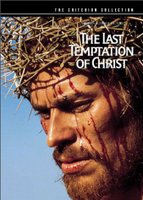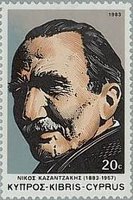Thoughts on "Last Temptation" (the Novel)
 Way back in February I started reading Nikos Kazantzakis's "Last Temptation" (in Greek "O Teleutaios Peirasmos"), the book that Martin Scorsese adapted for his 1988 film Last Temptation of Christ. I'd been meaning to read it ever since I first saw the film back in 2000, and the release of "Scandalizing Jesus?: Kazantzakis's The Last Temptation of Christ Fifty Years On", featuring an article by my friend (and oft quoted) Peter Chattaway finally spurred me on to get a copy.
Way back in February I started reading Nikos Kazantzakis's "Last Temptation" (in Greek "O Teleutaios Peirasmos"), the book that Martin Scorsese adapted for his 1988 film Last Temptation of Christ. I'd been meaning to read it ever since I first saw the film back in 2000, and the release of "Scandalizing Jesus?: Kazantzakis's The Last Temptation of Christ Fifty Years On", featuring an article by my friend (and oft quoted) Peter Chattaway finally spurred me on to get a copy. I must admit, one of the reasons it's taken me so long is that I wasn't particularly inspired by the first few chapters. Then what with a ton of books about babies to read (as well as a lot else), and never having been a great reader of novels anyway, it's taken me until the latter half of the summer to get around to finishing it off. I should add that I'm aware that I'm certainly no book critic, and so if I totally miss the point in anything that follows, please forgive me - these are only my initial impressions.
Overall I feel quite differently about the book and the film. The film in some places is fairly unpalatable, yet it also soars to places far higher than anywhere the book took me. Particularly significant in this is the characterisation of Jesus in both works. Dafoe's Jesus doesn't really seem to comprehend with the "Son of Mary" of the novel (who tends only to be called "Jesus" once his ministry gets going). Dafoe is far tougher and aggressive than his counterpart, not to mention far more Anglo-Saxon.
 Another interesting contrast is between how the two works use their run-time. I tend to divide the film into three sections. The prologue (from the start to Jesus leaving the monastery in the desert), the ministry (from the stoning of Magdalene to the crucifixion), and the temptation. The opening and closing sections last for about 40 minutes each, whereas the middle section lasts for roughly twice that. So it's roughly 1:2:1
Another interesting contrast is between how the two works use their run-time. I tend to divide the film into three sections. The prologue (from the start to Jesus leaving the monastery in the desert), the ministry (from the stoning of Magdalene to the crucifixion), and the temptation. The opening and closing sections last for about 40 minutes each, whereas the middle section lasts for roughly twice that. So it's roughly 1:2:1In the book on the other hand the prologue takes roughly 190 of 575 pages - about a third. But the temptation sequence lasts for only 60 pages - barely a tenth. So Scorsese significantly reduces the opening, and middle sections of the film to concentrate on the temptation sequence. Given both works are named after this sequence this is perhaps fair enough, but it does mean that Jesus comes off as weirder in the film than in the book.
 There are a few characters who were left out of the novel. Matthew (the tax collector and gospel writer), and Simon the Cyrenian are both wonderfully presented, and my two favourite passages in the book are Matthew's call and Simon's carrying of the cross. I've always had an affinity with Matthew (due to being named after him I guess), and so whilst I recognise Kazantzakis's history is perhaps a little off here, I'd like to quote this passage anyway.
There are a few characters who were left out of the novel. Matthew (the tax collector and gospel writer), and Simon the Cyrenian are both wonderfully presented, and my two favourite passages in the book are Matthew's call and Simon's carrying of the cross. I've always had an affinity with Matthew (due to being named after him I guess), and so whilst I recognise Kazantzakis's history is perhaps a little off here, I'd like to quote this passage anyway.Matthew went inside, closed his ledgers, put a blank one under his arm, wedged his bronze ink well into his belt and placed his quill behind his ear. Next, he removed a key from his belt, locked the shed and tossed the key into a garden. As soon as he had finished, he approached Jesus with trembling knees. Should he go forward, or not? Would the teacher offer him his hand? He raised his eyes and looked at Jesus as if imploring him to have pity...Jesus smiled at him and offered him his hand.(p.363)
 Sadly, there weren't many passages that I enjoyed that much. I found the dialogue quite clunky in places, particularly the spoken dialogue. Perhaps Kazantzakis was going for realism, or perhaps it's just a difficult work to translate, or the translation no longer captures what it once did. The strength of the novel is in it's concepts and ideas, combined with it's desire to take the humanity of Jesus seriously at a time when that was a risky business. Today such honest examination has been quickly bypassed in the rush to get to soulless, facile mocking. One only has to search for "Jesus" on YouTube to get the idea.
Sadly, there weren't many passages that I enjoyed that much. I found the dialogue quite clunky in places, particularly the spoken dialogue. Perhaps Kazantzakis was going for realism, or perhaps it's just a difficult work to translate, or the translation no longer captures what it once did. The strength of the novel is in it's concepts and ideas, combined with it's desire to take the humanity of Jesus seriously at a time when that was a risky business. Today such honest examination has been quickly bypassed in the rush to get to soulless, facile mocking. One only has to search for "Jesus" on YouTube to get the idea.Two final observations. Firstly, my opinion on the film's view of Jesus is that he (a imagines himself to have been a sinner (as do others), when in fact he isn't. As far as I recall, the novel confirms this. Secondly, some have criticised the temptation sequence as showing Jesus actually sinning, before going back in time. In my opinion, this is incorrect, even though there is some ambiguity. The book, however, is quite clear that these events never actually happen. What is interesting is that many of the other objectionable parts of the movie, were in fact added by Schrader and Scorsese.
I'll hopefully get around to reading and reviewing "Scandalizing Jesus?: Kazantzakis's The Last Temptation of Christ Fifty Years On", in the next few months.
Labels: Books, Last Temptation of Christ














1 Comments:
At 10:21 pm, February 13, 2011, Jake said…
Jake said…
The novel looks worse than the film. I've looked at quote after quote in this book. I remember a person said about the Jesus character of the Scorsese movie that he is a "limp wimp". But Jesus looks more like a "limp wimp" in this book than in the movie. The character Barabbas was in this book, and not in the film. Jesus pulled his heart out of his chest in the film, and not in the book. I mean, I looked at quote after quote in this book, and there were language words in it, some of them i've never heard of before. I mean, Kazantzakis acted like a jerk writing this book, acting like he doesn't believe that Christ was god's son. I've downloaded the entire text of the novel for me to read. I haven't printed it yet, but I'm going to read this soon. This novel had controversy all over it. Thanks!
Post a Comment
<< Home